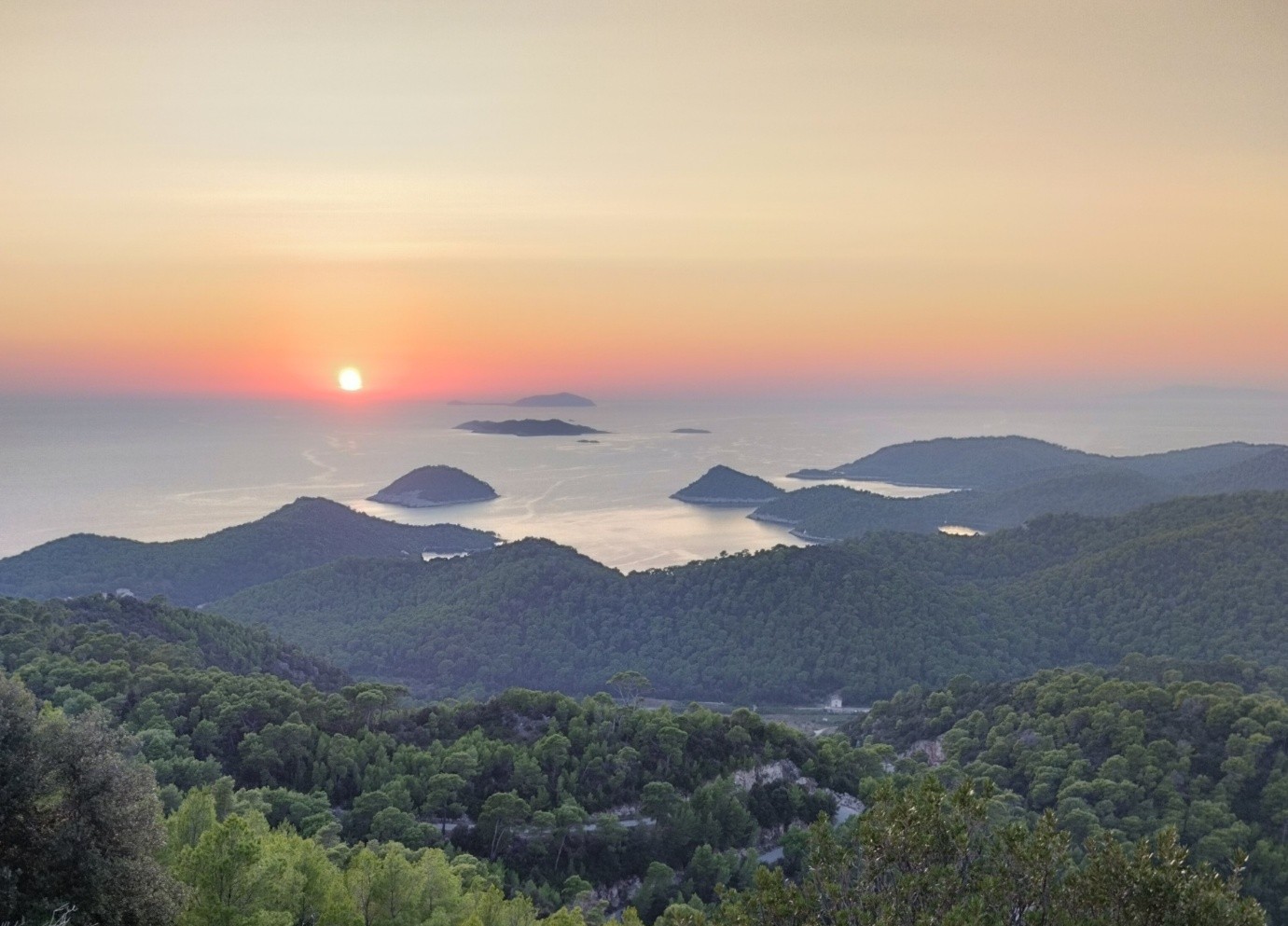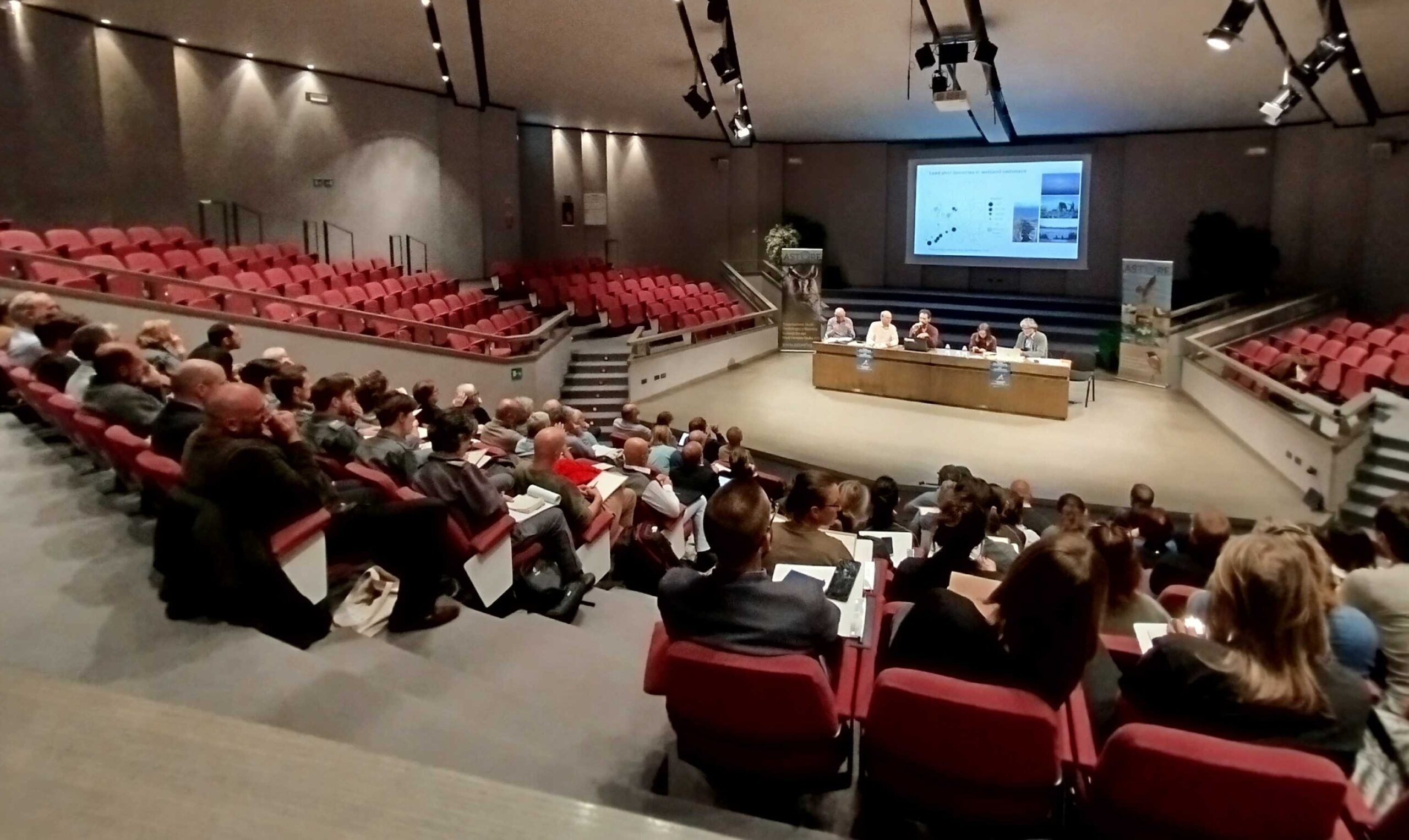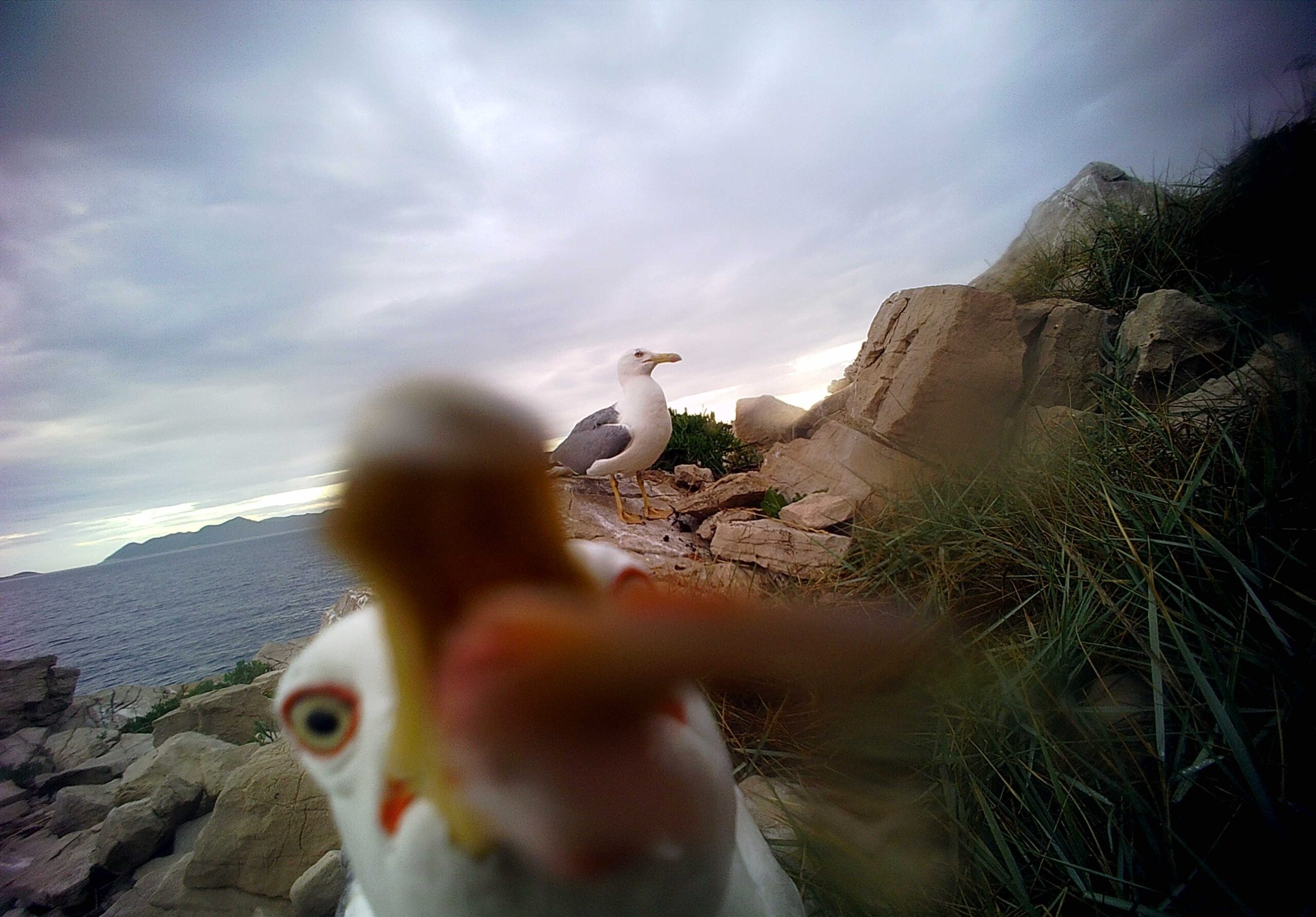The Still Water Revival Project, dedicated to the restoration of neglected water bodies in the regions of Biokovo, Dinara, North Velebit, and Učka, is still ongoing
Like small oases, ponds and wells are precious havens that, besides providing a vital drinking water source amidst the rugged karst landscape, enable the lives of numerous species. Amphibians and certain insects undergo all or part of their life cycle within these small freshwater ecosystems nestled among rocky formations. While traversing the Dinaric region, it is common to encounter wells or ponds bearing their own names, each intertwined with a unique local narrative and connection. Beyond serving as watering holes for grazing cattle, they stand as monuments to traditional craftsmanship.
While showing how Dinara is a hospitable host teeming with life and how its aquatic ecosystems are invaluable, we will present the restoration efforts we did alongside our partners.
RESTORED POOLS AND WELLS
Puddle near Budiša
The puddle formed in the gravel excavation in a dry field created by natural weathering of Dinaric rocks due to rain, snow, and freezing water in cracks. People utilized this gravel as a building material, digging it out and creating many hollows in the area. The gravel contains a significant amount of clay, which is washed downhill and accumulates at the bottom of the depressions, thus forming the puddle. Additionally, the trampling and grazing of numerous sheep, goats, and donkeys help maintain this puddle.
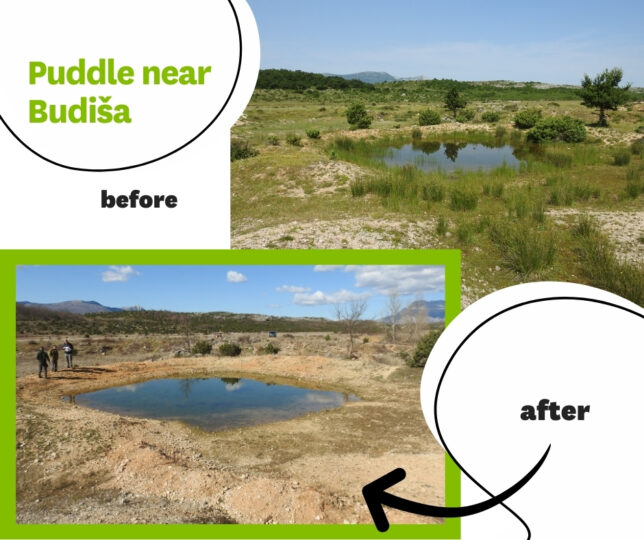 A small puddle in Malo Suhopolje
It is located in a small dry field, near the larger Ježevići dry field, situated in a natural depression with a clay waterproof layer. Since this depression is quite shallow, the puddle would have dried up before the summer and required renovation, meaning it needed to be deepened and a new layer of clay applied.
A small puddle in Malo Suhopolje
It is located in a small dry field, near the larger Ježevići dry field, situated in a natural depression with a clay waterproof layer. Since this depression is quite shallow, the puddle would have dried up before the summer and required renovation, meaning it needed to be deepened and a new layer of clay applied.
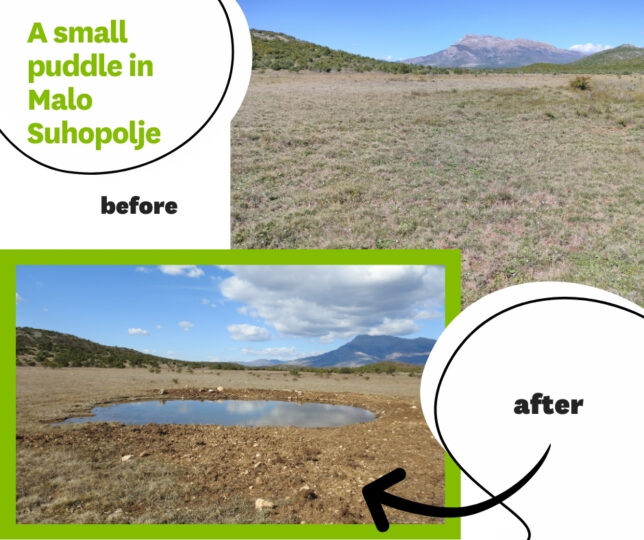 A large puddle in Mali Suhopolje
This puddle is larger and deeper than the neighboring one and is situated in a natural depression with a clay waterproof layer. During the summer, it can retain water, but in the absence of precipitation, the animals that use it would quickly drain it.
A large puddle in Mali Suhopolje
This puddle is larger and deeper than the neighboring one and is situated in a natural depression with a clay waterproof layer. During the summer, it can retain water, but in the absence of precipitation, the animals that use it would quickly drain it.
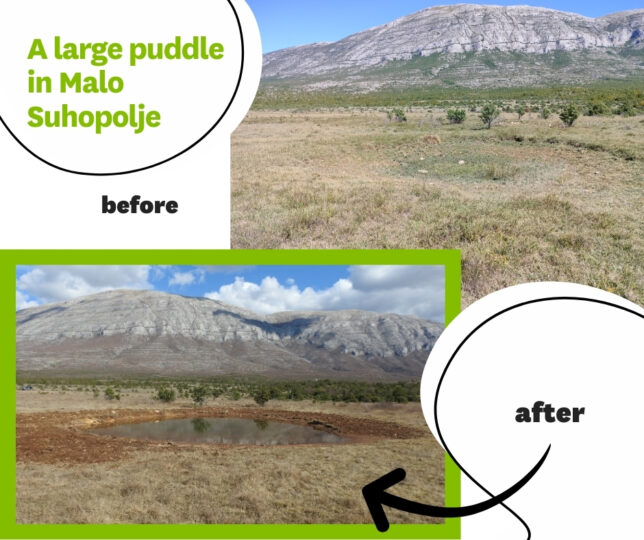 Muljika
During the volunteer camp with the Dragodid association and ESS volunteers, excavation for a new puddle began in the Muljika locality, within the broader area of Matkovina. The initially dug puddle was later deepened and widened to increase its volume and improve water retention. Finally, the clay excavated during digging was compacted along its edges to reinforce the waterproof layer of the puddle for the upcoming rains. Following the renovation, the puddle now measures approximately 6 meters wide and 70–80 cm deep, holding water effectively. There’s potential for further expansion and deepening in the future.
Muljika
During the volunteer camp with the Dragodid association and ESS volunteers, excavation for a new puddle began in the Muljika locality, within the broader area of Matkovina. The initially dug puddle was later deepened and widened to increase its volume and improve water retention. Finally, the clay excavated during digging was compacted along its edges to reinforce the waterproof layer of the puddle for the upcoming rains. Following the renovation, the puddle now measures approximately 6 meters wide and 70–80 cm deep, holding water effectively. There’s potential for further expansion and deepening in the future.
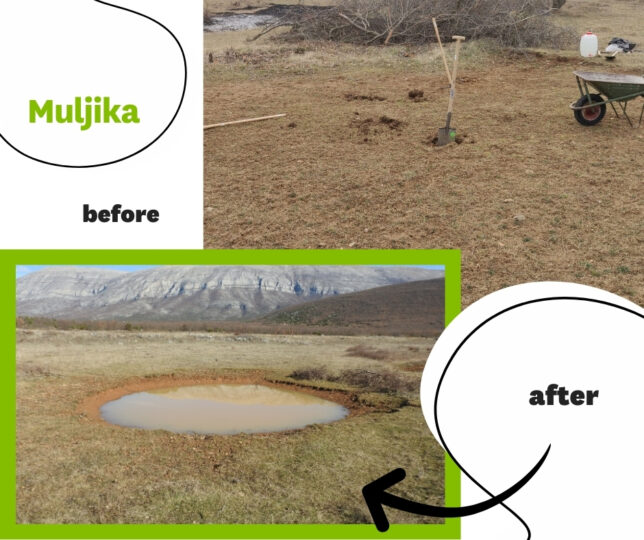 Varvodić puddle (Rože-Voštane)
The growth of new trees in and around the puddle, as well as animals trampling to reach the water and the effects of time, have led to a reduction in the water surface of the puddle. The outcome of this multi-generational process was evident in the encroaching blackberry bushes and scattered stones or collapsed walls. The pond was restored in the fall of 2023 during a volunteer camp organized by the Dragodid Association. The diligent efforts of the volunteers involved clearing the surrounding vegetation, reorganizing the stones, and reinforcing both the walls and the access points.
Varvodić puddle (Rože-Voštane)
The growth of new trees in and around the puddle, as well as animals trampling to reach the water and the effects of time, have led to a reduction in the water surface of the puddle. The outcome of this multi-generational process was evident in the encroaching blackberry bushes and scattered stones or collapsed walls. The pond was restored in the fall of 2023 during a volunteer camp organized by the Dragodid Association. The diligent efforts of the volunteers involved clearing the surrounding vegetation, reorganizing the stones, and reinforcing both the walls and the access points.
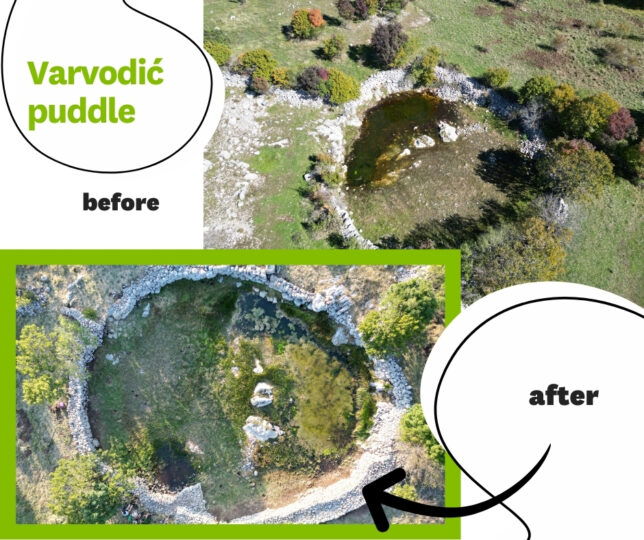 Pekasova draga well
This well underwent renovation during a volunteer camp in the fall of 2022. It’s primarily utilized by wild animals and passing herders guiding their sheep, goats, and horses towards summer grazing areas near Martinove Košare. The renovation included constructing access shelves, or steps, into the well, ensuring animals can reach the water even when levels are low, and greatly reducing the risk of wild animals drowning. Additionally, vegetation was cleared up to the approach of the well, and soil and stone deposits were excavated from within the well.
Pekasova draga well
This well underwent renovation during a volunteer camp in the fall of 2022. It’s primarily utilized by wild animals and passing herders guiding their sheep, goats, and horses towards summer grazing areas near Martinove Košare. The renovation included constructing access shelves, or steps, into the well, ensuring animals can reach the water even when levels are low, and greatly reducing the risk of wild animals drowning. Additionally, vegetation was cleared up to the approach of the well, and soil and stone deposits were excavated from within the well.
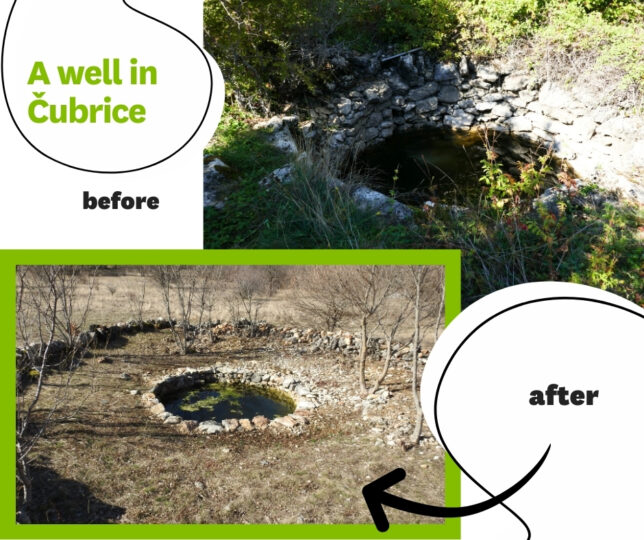 Kovačevac well
The Kovačevac well was restored with the help of volunteers during the Ježević drywall camp in 2022. Locals had noticed years before that water accumulated in the depression during rains, so they dug a well in the center and lined it with drywall. However, over time, it collapsed and became buried. Through several work sessions, we restored it, cleared the ground, removed large stones, and reinforced the well’s frame to prevent future collapse. Additionally, we created an access path using several large slab stones to navigate heavy water and mud since the well tends to overflow during heavy rains and melting snow, causing a puddle to form around it. After the water recedes, mud can remain for weeks, making it difficult for animals and people to access the well.
Kovačevac well
The Kovačevac well was restored with the help of volunteers during the Ježević drywall camp in 2022. Locals had noticed years before that water accumulated in the depression during rains, so they dug a well in the center and lined it with drywall. However, over time, it collapsed and became buried. Through several work sessions, we restored it, cleared the ground, removed large stones, and reinforced the well’s frame to prevent future collapse. Additionally, we created an access path using several large slab stones to navigate heavy water and mud since the well tends to overflow during heavy rains and melting snow, causing a puddle to form around it. After the water recedes, mud can remain for weeks, making it difficult for animals and people to access the well.
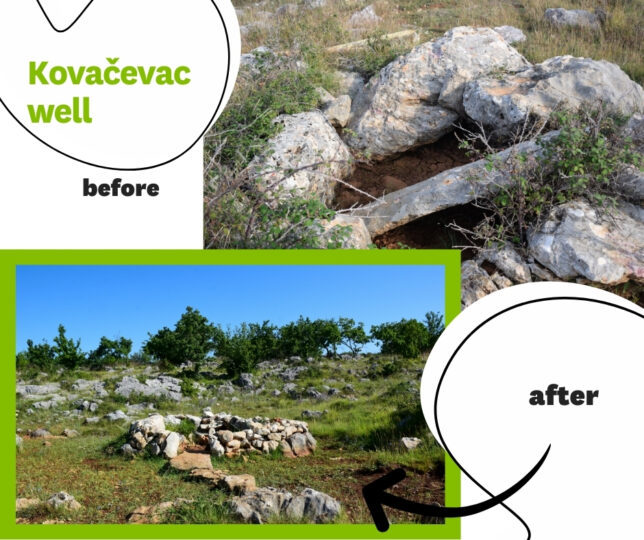 A well in Čubrice
This is a large and deep dry stone well located in a natural depression beneath the mountain village of Čubrice. The well was built by the locals in an underground stream and is about four meters deep, but over time it began to collapse and overgrow. Despite still holding water with uncertain access and sporadic visits, the ravages of time affected it most where it couldn’t be seen, underwater. Vegetation was cleared, then attention turned to critical parts of the well: removing an entire side and shifting it outward to reduce the wall’s slope and load. After repairing the foundation, all the material was removed, parts were rearranged, and construction began again, this time with steps, as this deep well had become a trap for animals during the summer.
A well in Čubrice
This is a large and deep dry stone well located in a natural depression beneath the mountain village of Čubrice. The well was built by the locals in an underground stream and is about four meters deep, but over time it began to collapse and overgrow. Despite still holding water with uncertain access and sporadic visits, the ravages of time affected it most where it couldn’t be seen, underwater. Vegetation was cleared, then attention turned to critical parts of the well: removing an entire side and shifting it outward to reduce the wall’s slope and load. After repairing the foundation, all the material was removed, parts were rearranged, and construction began again, this time with steps, as this deep well had become a trap for animals during the summer.
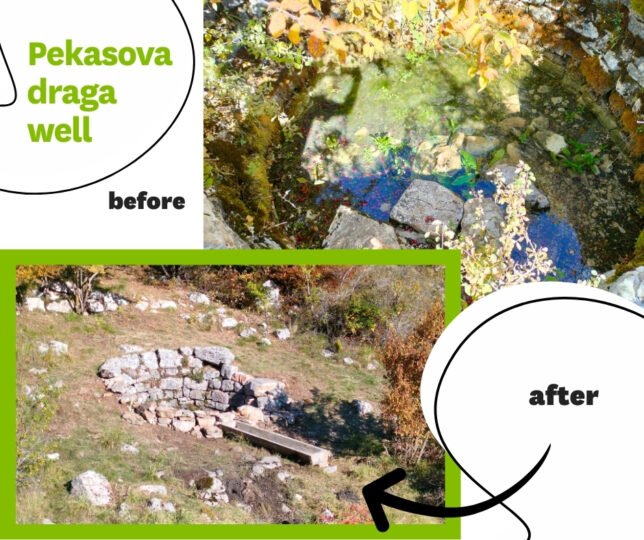 Translated by: Maja Dragojevic
Translated by: Maja Dragojevic A small puddle in Malo Suhopolje
It is located in a small dry field, near the larger Ježevići dry field, situated in a natural depression with a clay waterproof layer. Since this depression is quite shallow, the puddle would have dried up before the summer and required renovation, meaning it needed to be deepened and a new layer of clay applied.
A small puddle in Malo Suhopolje
It is located in a small dry field, near the larger Ježevići dry field, situated in a natural depression with a clay waterproof layer. Since this depression is quite shallow, the puddle would have dried up before the summer and required renovation, meaning it needed to be deepened and a new layer of clay applied.
 A large puddle in Mali Suhopolje
This puddle is larger and deeper than the neighboring one and is situated in a natural depression with a clay waterproof layer. During the summer, it can retain water, but in the absence of precipitation, the animals that use it would quickly drain it.
A large puddle in Mali Suhopolje
This puddle is larger and deeper than the neighboring one and is situated in a natural depression with a clay waterproof layer. During the summer, it can retain water, but in the absence of precipitation, the animals that use it would quickly drain it.
 Muljika
During the volunteer camp with the Dragodid association and ESS volunteers, excavation for a new puddle began in the Muljika locality, within the broader area of Matkovina. The initially dug puddle was later deepened and widened to increase its volume and improve water retention. Finally, the clay excavated during digging was compacted along its edges to reinforce the waterproof layer of the puddle for the upcoming rains. Following the renovation, the puddle now measures approximately 6 meters wide and 70–80 cm deep, holding water effectively. There’s potential for further expansion and deepening in the future.
Muljika
During the volunteer camp with the Dragodid association and ESS volunteers, excavation for a new puddle began in the Muljika locality, within the broader area of Matkovina. The initially dug puddle was later deepened and widened to increase its volume and improve water retention. Finally, the clay excavated during digging was compacted along its edges to reinforce the waterproof layer of the puddle for the upcoming rains. Following the renovation, the puddle now measures approximately 6 meters wide and 70–80 cm deep, holding water effectively. There’s potential for further expansion and deepening in the future.
 Varvodić puddle (Rože-Voštane)
The growth of new trees in and around the puddle, as well as animals trampling to reach the water and the effects of time, have led to a reduction in the water surface of the puddle. The outcome of this multi-generational process was evident in the encroaching blackberry bushes and scattered stones or collapsed walls. The pond was restored in the fall of 2023 during a volunteer camp organized by the Dragodid Association. The diligent efforts of the volunteers involved clearing the surrounding vegetation, reorganizing the stones, and reinforcing both the walls and the access points.
Varvodić puddle (Rože-Voštane)
The growth of new trees in and around the puddle, as well as animals trampling to reach the water and the effects of time, have led to a reduction in the water surface of the puddle. The outcome of this multi-generational process was evident in the encroaching blackberry bushes and scattered stones or collapsed walls. The pond was restored in the fall of 2023 during a volunteer camp organized by the Dragodid Association. The diligent efforts of the volunteers involved clearing the surrounding vegetation, reorganizing the stones, and reinforcing both the walls and the access points.
 Pekasova draga well
This well underwent renovation during a volunteer camp in the fall of 2022. It’s primarily utilized by wild animals and passing herders guiding their sheep, goats, and horses towards summer grazing areas near Martinove Košare. The renovation included constructing access shelves, or steps, into the well, ensuring animals can reach the water even when levels are low, and greatly reducing the risk of wild animals drowning. Additionally, vegetation was cleared up to the approach of the well, and soil and stone deposits were excavated from within the well.
Pekasova draga well
This well underwent renovation during a volunteer camp in the fall of 2022. It’s primarily utilized by wild animals and passing herders guiding their sheep, goats, and horses towards summer grazing areas near Martinove Košare. The renovation included constructing access shelves, or steps, into the well, ensuring animals can reach the water even when levels are low, and greatly reducing the risk of wild animals drowning. Additionally, vegetation was cleared up to the approach of the well, and soil and stone deposits were excavated from within the well.
 Kovačevac well
The Kovačevac well was restored with the help of volunteers during the Ježević drywall camp in 2022. Locals had noticed years before that water accumulated in the depression during rains, so they dug a well in the center and lined it with drywall. However, over time, it collapsed and became buried. Through several work sessions, we restored it, cleared the ground, removed large stones, and reinforced the well’s frame to prevent future collapse. Additionally, we created an access path using several large slab stones to navigate heavy water and mud since the well tends to overflow during heavy rains and melting snow, causing a puddle to form around it. After the water recedes, mud can remain for weeks, making it difficult for animals and people to access the well.
Kovačevac well
The Kovačevac well was restored with the help of volunteers during the Ježević drywall camp in 2022. Locals had noticed years before that water accumulated in the depression during rains, so they dug a well in the center and lined it with drywall. However, over time, it collapsed and became buried. Through several work sessions, we restored it, cleared the ground, removed large stones, and reinforced the well’s frame to prevent future collapse. Additionally, we created an access path using several large slab stones to navigate heavy water and mud since the well tends to overflow during heavy rains and melting snow, causing a puddle to form around it. After the water recedes, mud can remain for weeks, making it difficult for animals and people to access the well.
 A well in Čubrice
This is a large and deep dry stone well located in a natural depression beneath the mountain village of Čubrice. The well was built by the locals in an underground stream and is about four meters deep, but over time it began to collapse and overgrow. Despite still holding water with uncertain access and sporadic visits, the ravages of time affected it most where it couldn’t be seen, underwater. Vegetation was cleared, then attention turned to critical parts of the well: removing an entire side and shifting it outward to reduce the wall’s slope and load. After repairing the foundation, all the material was removed, parts were rearranged, and construction began again, this time with steps, as this deep well had become a trap for animals during the summer.
A well in Čubrice
This is a large and deep dry stone well located in a natural depression beneath the mountain village of Čubrice. The well was built by the locals in an underground stream and is about four meters deep, but over time it began to collapse and overgrow. Despite still holding water with uncertain access and sporadic visits, the ravages of time affected it most where it couldn’t be seen, underwater. Vegetation was cleared, then attention turned to critical parts of the well: removing an entire side and shifting it outward to reduce the wall’s slope and load. After repairing the foundation, all the material was removed, parts were rearranged, and construction began again, this time with steps, as this deep well had become a trap for animals during the summer.
 Translated by: Maja Dragojevic
Translated by: Maja Dragojevic



